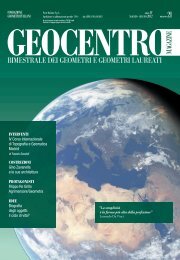Geocentro Magazine - numero 6 - novembre/dicembre 2009
Geocentro Magazine - numero 6 - novembre/dicembre 2009
Geocentro Magazine - numero 6 - novembre/dicembre 2009
Create successful ePaper yourself
Turn your PDF publications into a flip-book with our unique Google optimized e-Paper software.
http://commons.wikimedia.org/wiki/Leon_Battista_Alberti<br />
di un sistema cartografico di riferimento, in un punto<br />
posto in posizione centrale e, a partire da questo, rileva con<br />
l’Orizon le coordinate polari di ciascun particolare presente<br />
sul grafico, cioè direzioni e distanze dall’origine, così da<br />
costruire una tabella composta dai nomi e dalla posizione<br />
di ciascun particolare topografico rappresentato, come una<br />
sorta di pianta criptata. Tale tabella, ricavata dunque da<br />
una restituzione grafica e non da un rilevamento diretto<br />
sul territorio, costituisce un nuovo punto di partenza per<br />
il cartografo che volesse ottenere un’altra pianta, analoga a<br />
quella originaria, con la garanzia di restituire un modello<br />
perfettamente sovrapponibile al precedente.<br />
Tempio Malatestiano,<br />
opera rimasta incompiuta di Leon Battista Alberti<br />
Malatesta Temple,<br />
Leon Battista Alberti unfi nished work<br />
Santa Maria Novella, Firenze<br />
stvdio et diligenza in Roma (Modern Geographical Tables<br />
of the most part of the World, by diff erent authors and<br />
organised according to the Ptolemaic order, with drawings<br />
of various towns and fortresses, carefully printed through<br />
copper plates in Rome).<br />
Besides the economic aspects, however relevant they were,<br />
the most important element was the opening of new cultural<br />
horizons. Th ere was a true humus (“fertile ground”) that<br />
could bring to life the Italian “Cartographical Renaissance”.<br />
Th ese were the basis for the future achievements in this fi eld.<br />
Nevertheless, the renewed success of Ptolemy drove some of the<br />
most sedentary scholars to the conclusion that it was enough to<br />
read his Geographia in order to discover the whole World (or,<br />
as we would say today, to make “virtual travels”). A persuasion<br />
clearly testifi ed by the verses written by Ludovico Ariosto<br />
(Satira III, dedicate to Sir Annibale Malaguzzi, 1518):<br />
Th e libraries of the most important people were enriched by<br />
the new and sophisticated cartographical drawings of the<br />
Ptolemaic Atlases. In the meanwhile, the representations of<br />
the territory for practical purposes - property rights, natural<br />
resources employment, water fl ows regulations, legal contests,<br />
boundaries litigations between citizen or communities, access<br />
to rights on rural estates, forests or stretches of water – is still<br />
linked to descriptive representations, sometimes with sketches<br />
so naïf that could be today compared with child’s drawings.<br />
As an example, to understand how non-Ptolemaic<br />
63






